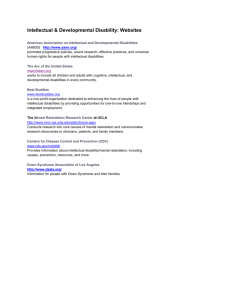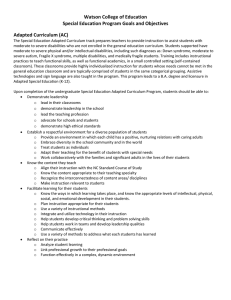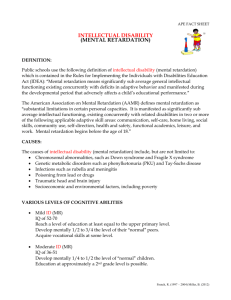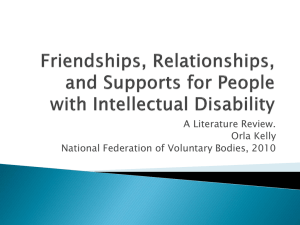Session 8 PowerPoint
advertisement
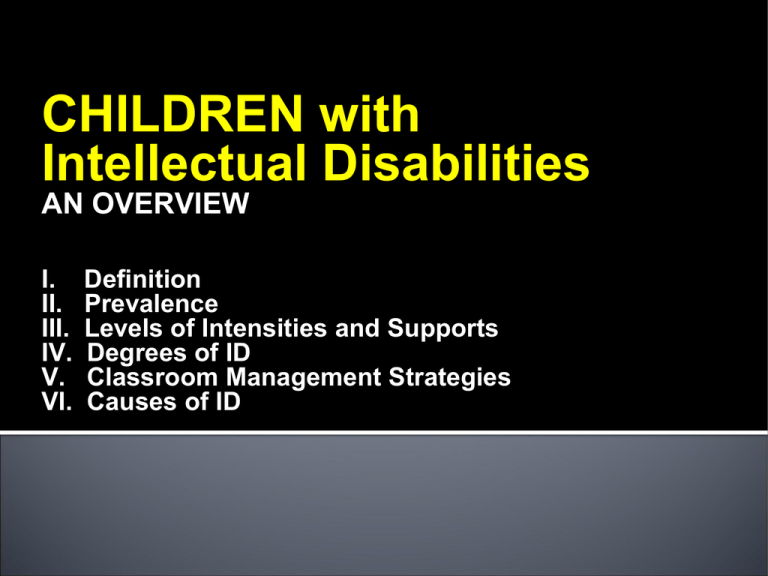
CHILDREN with Intellectual Disabilities AN OVERVIEW I. II. III. IV. V. VI. Definition Prevalence Levels of Intensities and Supports Degrees of ID Classroom Management Strategies Causes of ID • The Individuals with Disabilities Education Act (IDEA) provides the following technical definition for Mental Retardation: • “Mental Retardation means significantly sub-average general intellectual functioning existing concurrently with deficits in adaptive behavior and manifested during the developmental period, that adversely affects a child's educational performance." • "General intellectual functioning" is typically measured by an intelligence test. • Persons with Mental Retardation usually score 70 or below on such tests (or at least 2 standard deviations below the mean on the normal curve). • "Adaptive behavior" refers to a person's adjustment to everyday life. • It refers to an individual’s ability to meet social requirements of his or her community that are appropriate for his or her chronological age. It is an indication of independence and social competency. • Children with Intellectual Disabilities/Mental Retardation become adults; they do not remain "eternal children." They do learn, but slowly, and with difficulty. • Research suggest that approximately 1-2% of the general population has Intellectual Disabilities (when both intelligence and adaptive behavior measures are used). • • According to data reported to the U.S. Department of Education, there are approximately 611,076 students ages 621 were classified as having Intellectual Disabilities and were provided services by the public schools. This figure represents approximately 2 % of the total school enrollment for that year. • AAMR is the American Association on Mental Retardation • AAMR’s 2002 definition is based on how much “Levels and Intensities of Support” an individual with MR needs • AAMR is now the AAIDD – American Association of Intellectual and Developmental Disabilities. http://www.aamr.org/content_104.cfm • Supports are defined as the resources and individual strategies necessary to promote the development, education, interests, and personal well being of a person with Intellectual Disabilities. • Supports can be provided by a parent, friend, teacher, psychologist, and doctor or by any appropriate person or agency. The 4 Levels of Intensities and Supports (from least to most intensive and supportive) 1. 2. 3. 4. Intermittent Limited Extensive Pervasive • Support is not always needed. It is provided on an "as needed" basis and is most likely to be required at life transitions (e.g. moving from school to work). • Consistent support is required, though not on a daily basis. The support needed is of a nonintensive nature. • Regular, daily support is required in at least some environments (e.g. daily home-living support). • Daily extensive support, perhaps of a life-sustaining nature, is required in multiple environments. • Intellectual Disabilities may also be broken down into 4 sub-categories (Degrees): 1. 2. 3. 4. Mild Moderate Severe Profound This categorization is not as widely accepted as the AAID definition. • • • • • • IQ 55-69 Make up 85% of all ID cases. Can read up to 7th grade level. Require some supervision and support. Will require special education services. Can be in regular school with special ed. Services. • Can get jobs later in life and be relatively independent. • • • IQ 35-54 • Will need more Considered “trainable”. supervision later in life. Make up 10% of all ID • Can get jobs but will be cases. very basic semi-skilled • Need a very structured ones. classroom environment. • Difficulties with gross Normally taught in selfand fine motor contained classrooms. coordination. • • • • IQ 20-34 Make up about 3% of ID population. Goal is to teach daily living skills and survival skills. Will most likely have to live in a group home or special school. • • • • IQ less than 20. Severe problems in all areas of what was discussed with regard to Severe ID. Will need constant supervision. Have limited, if any speech. • Allow for many breaks throughout the school day. • Children with ID may require time to relax and unwind. Performing tasks will entail using more energy on their part and you must therefore allow them to take many breaks over the course of the school day. • • Always speak directly to the child so he can see you-Never speak with your back to him. The child with ID needs direct contact, and if your back is turned, he may not know that the attention you are giving him is actually being directed at him. • • Assign jobs in the classroom for the child so that he can feel success and accomplishment. Give him ones that you know he can succeed at and feel good about (i.e. erasing the blackboards). • • Build a foundation of success by providing a series of short and simple assignments. In this way, the child can gain a sense of confidence and success. • Provide the child with some simple job that requires the other students to go to him. For example, place him in charge of attendance and have him check off the children when they report in. • Strategies to achieve success • Provide opportunities for social success • Use direct instruction of social skills • Video Part 1 • Video Part 2 • Video Part 3 • ID can be caused by any condition which impairs development of the brain before birth, during birth or in the childhood years. • Several hundred causes have been discovered, but in about one-third of the people affected, the cause remains unknown. • Prenatal-Occurring before birth • Perinatal-Occurring during birth process • Postnatal-Occurring after birth • Down Syndrome • Phenylketonuria (PKU) • Fragile X Syndrome Down syndrome is an example of a chromosomal disorder. Chromosomal disorders happen sporadically and are caused by too many or too few chromosomes, or by a change in structure of a chromosome. Trisomy 21-Extra chromosome on #21 We have 23 pairs = 46 DS = 47 (3 on # 21) Older women are, greater the likelihood of Down’s Syndrome child. • A genetic disorder whereby the child is not able to break down an amino acid, phenylalanine (found in many common foods)-Failure to break down phenylalanine can lead to brain damage • Fragile X syndrome- a single gene disorder located on the X chromosome and is the leading inherited cause of Intellectual Disabilities. • Males: XY and Females are XX. • The most common inherited cause of ID. • CGG sequence in normal DNA occurs less than 50 times. In those with Fragile X it occurs more than 200 times. • More common in boys-They only have one X, so if the X is fragile, none other to compensate. • Illnesses: Childhood diseases such as: chicken pox & measles may lead to damages in the brain, as can accidents such as a blow to the head or near drowning. • Toxins: Lead, mercury and other environmental toxins can cause irreparable damage to the brain and nervous system. • • Poverty and cultural deprivation. Children in poor families may become Intellectually Disabled because of: • Malnutrition. • Disease-producing conditions. • Inadequate medical care. • Environmental health hazards.
